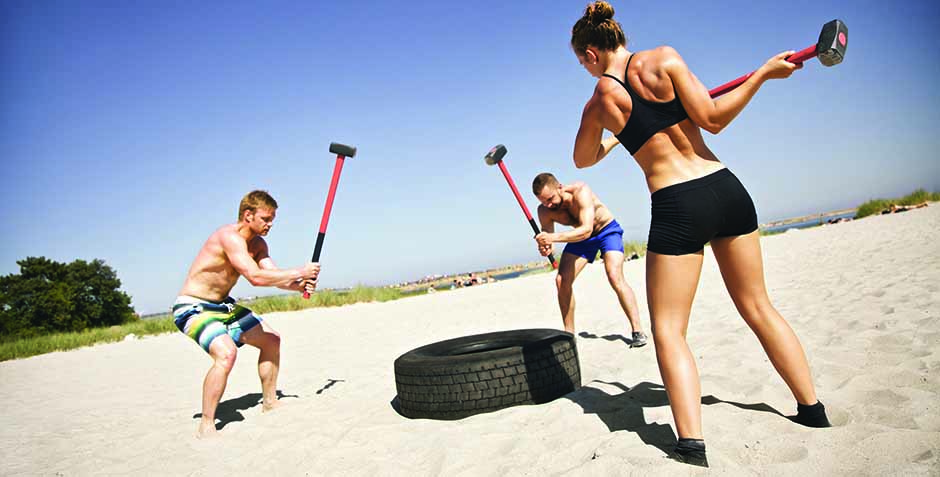Just a few decades ago, functional training was more of a medical concept than a fitness method. Physical and occupational therapists prescribed exercises to injured patients or elderly people to help them
But because balance and core stability are a vital part of nearly any action we do, it wasn’t long before functional training became synonymous with exercises performed on unstable surfaces—Swiss balls, Bosu trainers, wobble boards and the like—which were seen as a superior way to improve balance and activate core muscles. This prompted a flurry of research into this training method, and scientists eventually concluded that unstable surfaces limit how heavy a load people can handle. Many athletic trainers took that to mean unstable surfaces are best confined to the rehab arena, and thus, the Swiss ball’s glory days came to an end.
So where does that leave us now? With a lot of questions about functional training. Even so, it’s still the most effective way for anyone to exercise. Here we define and demystify functional fitness, and coach you on the best way to employ it, regardless of your athletic or fitness goals.
A DEFINITIVE DEFINITION
At its core, functional training is straightforward: It simply means exercising to prepare your body to perform a specific task, whether it be sprinting a certain distance, tackling a wide receiver, shoveling snow or simply standing up off the floor. And that’s where confusion enters: Functional training is different for every person, and for every action you perform.
“In tennis or soccer, you need to teach your body to perform explosive, powerful movements,” says David Behm, Ph.D., exercise physiologist, professor and researcher at the Memorial University of Newfoundland. “If you’re a dog walker, you can move a lot more slowly.”
That said, there are four basic functional-fitness principles to keep in mind whether you’re training for a marathon or for keeping up with your kids at the park. Incorporate these concepts into any fitness regimen, and you’re guaranteed to make it more efficient and, ultimately, more effective.
1. MASTER THE MECHANICS.
Functional fitness reinforces the natural movement of the body and unlocks its potential. But first you have to understand how the body should actually move, says Josh Henkin, C.S.C.S., owner of Ultimate Sandbag Training and a strength coach with 20-plus years of experience. “Whether you’re an elite athlete or an everyday person, functional training is philosophically the same,” he explains. “It’s a fallacy that athletes know how to move correctly. Often the reason they have injuries is because they’ve never been taught to move well. And people who are training for everyday health need proper movement mechanics, too. Once they have that, they can add progressions that achieve the specific outcomes they desire.”
Take action: Before you dive into a functional-training program, book a session with a certified personal trainer who can assess your knowledge of proper movement patterns.
2. MIMIC THE MOTIONS.
Functional fitness exercises are ones that imitate how you will actually move, whether in a particular sport or in everyday life, Behm says. For example, a tennis player and a snow shoveler— who both need to generate power while standing up and rotating their bodies—might incorporate explosive “wood chop” exercises into their strength routines, while a hiker might emphasize stair workouts. This develops not just strength and power, but also your brain and your reflexes. “The nervous system has to be trained just as the muscles do,” Henkin says.
Take action: List the major motions and physiological demands of your sport or activity, and determine how best to mimic those actions.
3. INTEGRATE, DON’T ISOLATE.
Functional training experts advocate compound-joint movements (say, a chin-up) over single-joint ones (a biceps curl). “Very few things we do in our lives are isolated movements,” Behm says. “Compound-joint exercises improve balance and coordination, and help you transfer the skills you gain to everyday life.” To explain why, Henkin again points to the central nervous system. For example, he says, studies show that the quadriceps function differently in a leg extension (an isolated exercise) than they do in an integrated exercise like a squat, which better mimics everyday movement.
Take action: Seek out compound-joint exercises to replace any single-joint movements in your routine. Again, a trainer can help with this.
4. MAP OUT PROGRESSIONS.
Once you’ve mastered basic movements, you need to challenge your body with exercise progressions. In traditional training, this usually means greater volume, load (weight) or intensity. But this is what puts the “fun” in functional fitness: Progressions often experiment with movement in different planes (front to back, up and down, side to side, rotational) and with a variety of surfaces or loads. Popular progression tools include unstable surfaces—such as sand, Swiss balls and Bosu balls—and unstable loads like sandbags, buckets of water and suspension-training systems such as TRX. The key idea here: All of these methods have merit, but they tend to work best when used as part of a broader training plan.
Take action: See “Tool Talk” to discern which of these training methods best fit into your routine.

